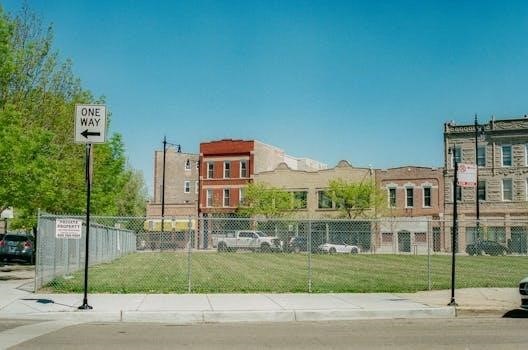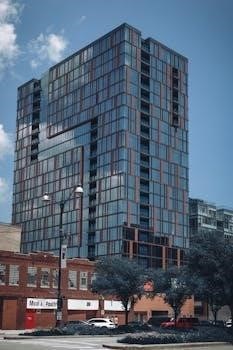Chicago Residential Lease PDF⁚ A Comprehensive Guide
Navigating the Chicago rental market requires a solid understanding of the residential lease․ This guide offers a comprehensive overview of Chicago residential lease PDF documents‚ including key components and compliance with local ordinances․ It will help landlords‚ tenants‚ and property managers․
Understanding the Illinois Lease Agreement
An Illinois lease agreement serves as a legally binding contract between a landlord and a tenant‚ granting the tenant the right to use a residential property in exchange for rent․ It is crucial to ensure a mutual understanding before signing‚ as the lease becomes binding for the agreed term․ In Chicago‚ standard lease agreements often include essential attachments like the Chicago Residential Landlord Tenant Ordinance Summary․ These documents are crucial for both landlords and tenants to understand their rights and responsibilities under Illinois law; Always consult with an attorney if you have any questions about the legality of the form․
For properties within Chicago‚ the lease must comply with the Chicago Residential Landlord and Tenant Ordinance (CRLTO)․ The agreement should detail aspects such as utilities‚ the duration of tenancy‚ security deposit regulations‚ and any other pertinent fees․ Landlords often use a rental application to screen prospective tenants․ The Illinois Association of Realtors also provides a standard residential agreement‚ commonly used by realtors․
It is essential to use the most current version of the lease agreement‚ as judges recognize the importance of up-to-date forms․ Property management companies and real estate agents find these templates invaluable for ensuring uniformity across multiple leases․
Key Components of a Chicago Residential Lease
A Chicago residential lease agreement comprises several key components that define the terms and conditions of the rental arrangement․ It begins with identifying the parties involved⁚ the landlord and the tenant(s)‚ including their full names and contact information․ The lease must clearly state the address of the property being leased‚ providing a precise description of the premises․
The term of the lease‚ specifying the start and end dates‚ is a critical element․ The amount of rent due each month‚ along with the acceptable methods of payment and any late fee policies‚ must be explicitly outlined․ Details regarding the security deposit‚ including the amount‚ conditions for return‚ and interest accrual (if applicable)‚ must adhere to Chicago regulations․
The lease should also cover utilities‚ specifying which party is responsible for payment․ Rules regarding pets‚ subleasing‚ and any restrictions on alterations to the property should be clearly stated․ Finally‚ the lease should include clauses addressing termination‚ renewal options‚ and procedures for handling disputes‚ ensuring both parties understand their rights and obligations throughout the tenancy․
Chicago Residential Landlord and Tenant Ordinance (CRLTO) Compliance
Compliance with the Chicago Residential Landlord and Tenant Ordinance (CRLTO) is paramount when drafting a residential lease․ The CRLTO sets forth specific rights and obligations for both landlords and tenants‚ aiming to create a fair and equitable rental environment․ Landlords must ensure their leases align with the CRLTO’s provisions to avoid legal repercussions․
Key aspects of CRLTO compliance include providing tenants with a summary of the ordinance attached to the lease․ The lease should also accurately reflect CRLTO guidelines on security deposits‚ including interest payment requirements and timelines for return․ Landlords must adhere to CRLTO regulations regarding access to the property‚ repairs‚ and eviction procedures․
The CRLTO also addresses issues such as lead-based paint disclosure‚ bed bug infestation‚ and domestic violence protections․ Failure to comply with the CRLTO can result in fines‚ penalties‚ and legal action․ Therefore‚ landlords must thoroughly review and understand the CRLTO to ensure their lease agreements are fully compliant‚ protecting both their interests and the rights of their tenants․
Required Disclosures in Chicago Leases
Chicago leases necessitate several mandatory disclosures to ensure transparency and protect tenants’ rights․ Landlords must provide tenants with specific information about the property and its history‚ as well as potential hazards․ Failing to include these disclosures can lead to legal consequences and invalidate the lease agreement․

One crucial disclosure is the Lead-Based Paint Disclosure‚ especially for properties built before 1978․ Landlords must inform tenants of any known lead-based paint hazards and provide a pamphlet on lead poisoning prevention․ Another essential disclosure is the Radon Hazard Disclosure‚ which alerts tenants to the presence of radon gas in the building․
Additionally‚ landlords must disclose information about the building’s heating costs for the past two years․ This Heating Cost Disclosure Statement helps tenants estimate their future heating expenses․ Furthermore‚ landlords must provide a bed bug disclosure‚ outlining the property’s history of bed bug infestations and the measures taken to address them․ Adhering to these disclosure requirements is crucial for maintaining legal compliance and fostering a fair rental environment in Chicago․

Standard Attachments to a Chicago Lease Agreement
A Chicago residential lease agreement typically includes several standard attachments that provide additional information and clarify the rights and responsibilities of both landlords and tenants․ These attachments are essential for ensuring compliance with the Chicago Residential Landlord Tenant Ordinance (CRLTO) and other applicable laws․
One common attachment is the CRLTO Summary‚ which provides a concise overview of the ordinance’s key provisions․ This summary helps tenants understand their rights and obligations under the CRLTO․ Another standard attachment is the Security Deposit Interest Rate Summary‚ which outlines the interest rate that landlords must pay on security deposits held for more than six months․

The Heating Cost Disclosure Statement is another crucial attachment‚ providing information on the property’s heating costs for the past two years․ This helps tenants estimate their future heating expenses․ Additionally‚ the Lead-Based Paint Disclosure and Pamphlet are often included‚ especially for properties built before 1978․ Finally‚ a Move-in/Move-out Checklist is a standard attachment that allows tenants to document the condition of the property at the beginning and end of the lease term․ These attachments are vital components of a comprehensive Chicago lease agreement․
Where to Find a Chicago Residential Lease PDF Template
Finding a suitable Chicago residential lease PDF template is crucial for landlords and property managers to ensure compliance with local laws and regulations․ Several resources offer these templates‚ catering to various needs and preferences․
One option is to check with real estate associations‚ such as the Illinois Association of Realtors‚ which may provide standard lease agreements for their members․ Property management companies often have their own templates‚ which they may share or offer as part of their services․ Online legal document providers also offer customizable lease templates specifically designed for Chicago properties․
Additionally‚ some websites specialize in providing free or low-cost lease templates‚ which can be a convenient option for landlords on a budget․ When selecting a template‚ it’s essential to ensure that it complies with the Chicago Residential Landlord Tenant Ordinance (CRLTO) and includes all required disclosures and attachments․ Always review the template carefully and consult with an attorney if you have any questions or concerns․ Remember to verify that the template is up-to-date and reflects the latest legal requirements․ These templates are fillable‚ available for download․
Fillable PDF Format and its Importance
The fillable PDF format has become increasingly popular for Chicago residential lease agreements‚ and for good reason․ Its importance lies in its user-friendliness and efficiency‚ benefiting both landlords and tenants throughout the leasing process․
A fillable PDF allows for easy completion of the lease agreement on a computer or mobile device․ Landlords can quickly fill in the necessary information‚ such as property address‚ rent amount‚ and lease term‚ without the need for manual typing or handwriting․ Tenants can also easily review and complete their sections of the lease‚ ensuring accuracy and clarity․
The digital format also simplifies the sharing and storage of lease agreements․ Landlords can easily email the fillable PDF to prospective tenants‚ and both parties can save a digital copy for their records․ This eliminates the need for physical copies‚ reducing paper waste and making it easier to access the lease agreement whenever needed․
Furthermore‚ fillable PDFs often include features such as digital signatures‚ which allow for legally binding electronic signatures․ This streamlines the signing process and eliminates the need for in-person meetings or physical document exchange․

The Importance of Using the Latest Version
In the ever-evolving landscape of Chicago’s rental market‚ using the latest version of a residential lease agreement is paramount․ Legal requirements and tenant rights are subject to change‚ making outdated forms a potential source of legal complications and financial risks for both landlords and tenants;
The Chicago Residential Landlord and Tenant Ordinance (CRLTO) undergoes periodic updates‚ impacting various aspects of the lease agreement‚ including required disclosures‚ security deposit regulations‚ and eviction procedures․ Employing an obsolete lease version might mean overlooking crucial clauses or failing to adhere to current legal mandates‚ leading to disputes or even legal action․
Moreover‚ the latest lease versions often incorporate clarifications and improvements based on court rulings and interpretations of existing laws․ These updates ensure that the lease agreement is comprehensive‚ unambiguous‚ and fully compliant with the prevailing legal framework․
For landlords‚ utilizing the most recent version demonstrates a commitment to fair and transparent rental practices‚ fostering positive tenant relations․ It also mitigates the risk of penalties or legal challenges arising from non-compliance․
Tenants also benefit from using the latest version‚ as it ensures their rights are protected and they are fully informed of their obligations under the lease․
Essential Information to Fill Out in the Lease
A Chicago Residential Lease Agreement is a legally binding document‚ and accurately completing all sections is crucial for both landlords and tenants․ Several key pieces of information must be meticulously filled out to ensure clarity and avoid future disputes․
Firstly‚ the names of all parties involved – the landlord or property management company and all adult tenants – must be clearly stated․ The property address‚ including the apartment number if applicable‚ should be accurate and complete․ The lease term‚ specifying the start and end dates‚ needs to be clearly defined‚ along with the agreed-upon monthly rent amount and due date․
Details regarding the security deposit‚ including the amount‚ where it will be held‚ and the conditions for its return‚ are essential․ Furthermore‚ the lease should outline which utilities are the tenant’s responsibility and which are covered by the landlord․
Any specific rules or regulations pertaining to the property‚ such as pet policies‚ parking restrictions‚ or noise restrictions‚ should be clearly stated in the lease․ It’s also important to include clauses addressing late payment fees‚ procedures for repairs‚ and consequences for lease violations․
Finally‚ all required disclosures mandated by the Chicago Residential Landlord and Tenant Ordinance (CRLTO)‚ such as lead-based paint disclosure and radon hazard disclosure‚ must be included and acknowledged by both parties․
Rights and Obligations Covered by the Ordinance
The Chicago Residential Landlord and Tenant Ordinance (CRLTO) establishes a framework of rights and obligations for both landlords and tenants in the city․ Understanding these provisions is critical for a harmonious rental experience․ The ordinance covers a wide range of issues‚ ensuring fair practices and protecting vulnerable parties․
Tenants have the right to a safe and habitable dwelling‚ including essential services such as heat‚ water‚ and electricity․ Landlords are obligated to maintain the property in good repair and address necessary repairs promptly․ The CRLTO also regulates security deposits‚ outlining how much can be charged‚ where it must be held‚ and the procedures for returning it to the tenant upon lease termination․
Furthermore‚ the ordinance addresses issues such as access to the property‚ notice requirements for entry‚ and procedures for eviction․ Landlords must provide tenants with a summary of the CRLTO and comply with specific disclosure requirements‚ including lead-based paint and radon hazards․
The CRLTO also outlines the responsibilities of tenants‚ including paying rent on time‚ maintaining the property in a clean and safe condition‚ and respecting the rights of other tenants․ Both landlords and tenants have the right to seek legal recourse if the other party violates the terms of the lease or the provisions of the ordinance․ Familiarity with these rights and obligations is essential for navigating the Chicago rental market successfully․
Consequences of Non-Compliance
Failure to comply with the Chicago Residential Landlord and Tenant Ordinance (CRLTO) can result in significant legal and financial consequences for both landlords and tenants․ The ordinance is designed to protect the rights of both parties‚ and violations can lead to disputes‚ lawsuits‚ and penalties․
For landlords‚ non-compliance can result in fines‚ damages‚ and the inability to enforce certain lease provisions․ For example‚ if a landlord fails to provide a tenant with a summary of the CRLTO or fails to maintain the property in a habitable condition‚ the tenant may have grounds to terminate the lease or withhold rent․ Landlords may also be liable for attorney’s fees and court costs if they are found to be in violation of the ordinance․
Tenants who violate the CRLTO can face eviction‚ lawsuits for unpaid rent‚ and damage to their credit scores․ Failure to pay rent on time or causing damage to the property can be grounds for eviction․ Tenants may also be held liable for attorney’s fees and court costs if they are found to be in violation of the lease or the ordinance․
It is essential for both landlords and tenants to understand their rights and obligations under the CRLTO to avoid the consequences of non-compliance․ Seeking legal advice from an attorney specializing in landlord-tenant law can help ensure compliance and protect your interests․
